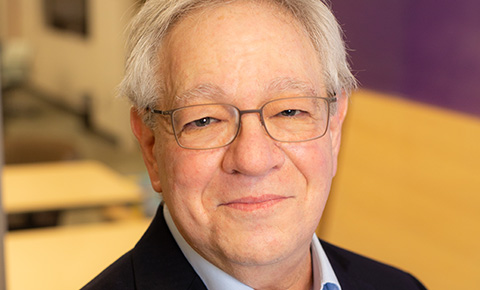OpenSciEd, Northwestern Launch New Chemistry Course

Most of us have seen a bright flash of lightning streak across the sky, but have we ever wondered where the lightning comes from or why it strikes where it does?
In a new chemistry course for high school students, OpenSciEd asks students to examine slow-motion videos of lightning strikes to explore these questions and more. What is lightning? What causes lightning to strike? And why are some structures safer than others when lightning strikes?
“Our goal at OpenSciEd is to really open up science to all students,” said Brian Reiser, the Orrington Lunt Professor of Learning Sciences at Northwestern's School of Education and Social Policy. “We want students to see science as relevant to the problems they, their families, and their communities care about.”
OpenSciEd is a collaborative effort to create high-quality, open-access classroom materials for teachers nationwide. Designed for elementary, middle, and high school students, these free and downloadable units are aligned with the Next Generation Science Standards (NGSS) and lay the groundwork for the future of science education.
Each OpenSciEd unit is anchored in a relevant phenomenon or problem that students work through together. The newest curriculum, which integrates chemistry with Earth and space science, was developed through a partnership between the Next Generation Science Storylines project at Northwestern University—led by Reiser—and researchers at the University of Colorado Boulder, high school teachers from across the country, and the team at OpenSciEd.
In the unit on lightning, which covers the structure and properties of matter, students discuss the relationships between changes in matter, energy transfer, and force interactions. Through their own questions and investigations, they develop a model explaining how interactions between molecules can lead to the large amounts of energy transferred across a distance to form lightning.
Other chemistry units explore global human impacts on the planet, including sea-level rise, oyster die-offs, energy sources for transportation, and how to produce, find, or recycle the substances needed to sustain life on Earth.
“Using real-world contexts to develop chemistry understandings helps students see the interconnected nature of chemistry and Earth and space science,” said Nicole Vick, chemistry course lead and curriculum development specialist on the Next Generation Storylines team.
“Many of the challenges facing global society today require an interdisciplinary understanding of science and careful thought about the impacts of decision-making at multiple scales,” Vick said.
Science Storylines
For Reiser, the days of asking students to simply memorize facts and explanations are long gone. “Instead, teachers need to help students engage in investigations, explanations, and scientific argumentation so they can figure out the world around them,” he said.

In 49 states and the District of Columbia, U.S. schoolchildren are learning science guided by science standards based on The Framework for K-12 Science Education, including the NGSS. In this new vision of science education, students build and apply science ideas, rather than simply learning about the science done by others.
These standards require new curricula to achieve these goals. In response, OpenSciEd—a consortium of curriculum developers and science education leaders—began creating a robust set of research-based, open-source K-12 science instructional materials and professional development resources for teachers.
Northwestern played a major role in conceiving and writing the lessons. The units are based on Next Generation Science Storylines, an approach developed by Reiser, Michael Novak, senior curriculum developer, and Tara McGill, curriculum development specialist.
Science storylines start with real-world problems that spark students' questions, which in turn drive the learning. This approach highlights a key instructional shift in the NGSS that is often missing from traditional science instruction: connecting science to students' own lives.
The units are developed with input from teachers and students in 310 schools and field-tested before being released to the public. In the Polar Ice chemistry unit, for example, the team initially placed the climate-change-focused content at the end. However, after feedback from teachers, they moved it to the beginning of the unit.
“Seeing what made sense to students—and what did or didn’t work—helped push our thinking in new directions,” said Dan Voss, curriculum development specialist on the Storylines team.
In addition to chemistry, OpenSciEd High School includes biology courses designed by the University of Colorado Boulder and a high school physics course developed by BSCS Science Learning. All three courses are aligned with the Next Generation Science Standards and are intended to provide students with a rigorous science education to prepare them for college and STEM careers.
Experts from the Dana Center at the University of Texas at Austin, Denver Public Schools, and Science Educators for Social Justice and Diversity, along with collaborating teachers from across the country, also contributed to the design of the materials.
OpenSciEd High School was guided by the nonprofit organization OpenSciEd with support from the Bill & Melinda Gates Foundation, the Carnegie Corporation of New York, the Walton Family Foundation, and the William and Flora Hewlett Foundation.
All 16 units have earned the "High Quality Next Generation Science Standards Design" badge from WestEd’s Science Peer Review Panel. OpenSciEd materials are freely available in both print-ready PDFs and as editable Google Docs, giving teachers, schools, and districts more flexibility. The organization’s mission is to eliminate as many barriers as possible to accessing and using high-quality materials.
Photo courtesy of Willi Wilkens/National Weather Service